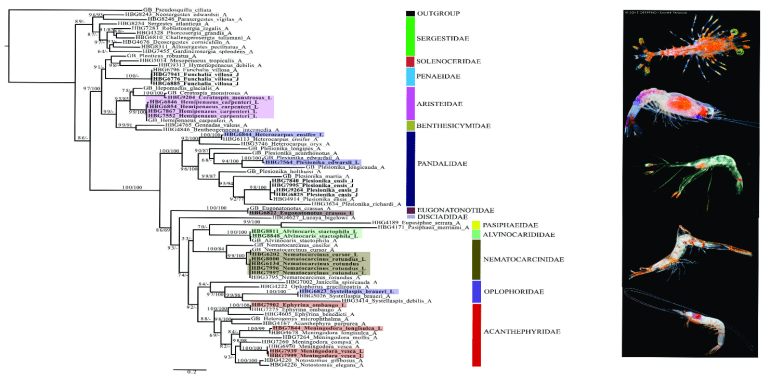The mysteries observed in the vast oceans of the world never cease to amaze us, and recently scientists discovered a group of strange little monsters, some of which had never been seen before.
The researchers' painstaking work has revealed that these strange shapes are tiny larvae of shrimp, prawns and other creatures that inhabit some of the deepest and darkest points of the oceans.
The study, published in the journal "Diversity", showed that the strange creatures surrounding coral reefs in the depths of the Gulf of Mexico, do not actually represent new types of organisms, but rather are organisms that have been wrongly classified before.
Examples of stages of development of deep sea crabs in the northern Gulf of Mexico (Diversity Journal)
It's very difficult
Identification of deep-sea larvae (>200 m) is very difficult due to the morphological diversity across embryonic development stages, the early developmental stages often differing distinctly from their adult form, representing a strange and mysterious world that remains to be explored.
Classifying where the organisms belong in the tree of life is difficult at best, especially when you look at tiny samples plucked from the open ocean at depths as great as 1,500 metres.
In the past, the only specimens scientists had to deal with were semi-digested specimens found in the guts of fish such as tuna and dolphins, or specimens described nearly two centuries ago, such as a type of shrimp that lives in the abyssal plains of the ocean as deep as 5,000 meters below. Surface.
Many families of deep-sea shrimp are "fraught with taxonomic problems", because rare and unusual larval stages have been incorrectly described as new genera or species.
Prior to this study, scientists knew almost nothing about the larval stages of 10 of the 14 deep-sea species described, as difficulties with sampling and deep-sea larval rearing, combined with a lack of taxonomic expertise, required the use of molecular methods to aid identification. .
Results
In the current study, one of the larvae samples, which live in cold water intrusion at depths of a thousand meters, were found in deeper waters than previously expected, and another species known to perform daily vertical migrations through the water column was identified, and ascends at night from depths of about 2600 meters to a distance of 50 meters from the surface for feeding.
In both cases, matching the shapes of small species to adults is a crucial link in understanding where shrimp and other crustaceans live in the deep sea and their place in the food web, because crustacean larvae are important in the food chain, as they are often the main food source for migratory fish, cephalopods and some Marine mammals that dive to the depths.
"Many species progress through a series of larval stages," marine scientists Heather Bracken Grissom and graduate student Carlos Varela at Florida International University wrote in a press release on Oct. 18. It is recognizable by its adult counterpart.
The duo tested, drew, measured, and described some of the strange creatures collected on eight research expeditions in the northern Gulf of Mexico and nearby waters, many of which had never been seen before, and others that scientists found difficult to grow in the lab.
Grissom Volcanoes explains that "a lot of these larvae are found in the middle seas area in open waters between 200 and 1,000 meters and then settle to the bottom of the deep sea when they grow up."
But the researchers suspect that these little-known shrimp species likely contain multiple larval stages - which can be affected by seawater temperature, salinity and the food they eat - so more work and samples will be needed to fully describe the secret life of these deep species. .
The researchers matched 14 species of larvae with their adult counterparts using several methods (Diversity Journal).
barcode method
The researchers matched 14 species of larvae with their adult counterparts using morphological methods combined with the "barcode" method, a classification method that uses a short genetic tag in the DNA of organisms to identify their species, to match larval stages. With its adult counterpart from the northern Gulf of Mexico and adjacent waters.
"For many groups, larval descriptions are missing or nonexistent," the researchers wrote.
What they have revealed is the presence of a dazzling array of larvae of different species of deep-sea shrimp, adding new pieces to the puzzle of their complex life cycles.
Therefore, this study represents the first step to advance knowledge of the larval diversity of many groups of organisms in the deep sea in order to understand the evolution, distribution and ecology of marine organisms, as well as their impact on community and ecosystem processes.

